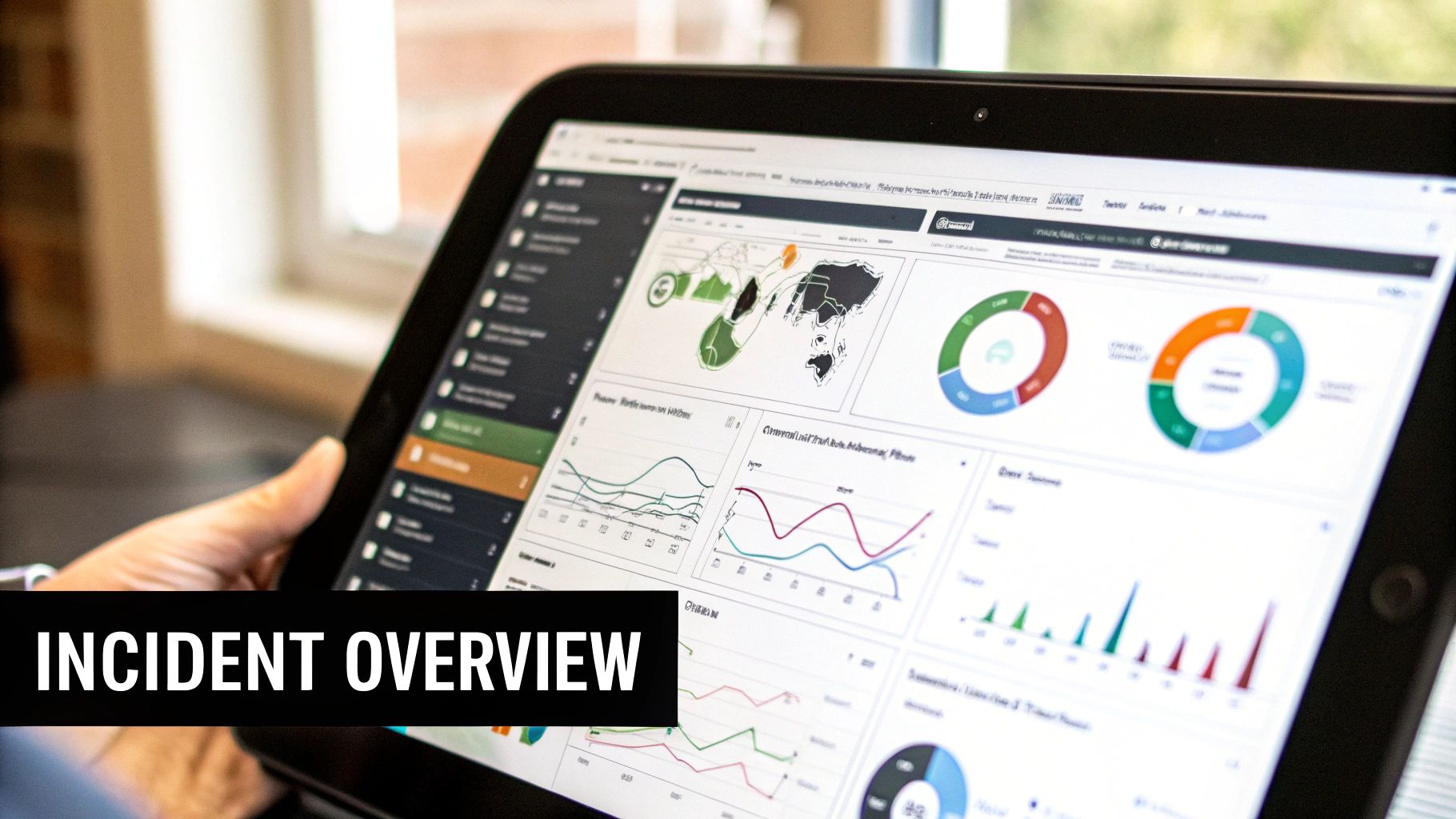10 Security Incident Report Examples: A Complete Guide for Modern Documentation
Building Effective Security Incident Reports

When a security breach occurs, having clear documentation is essential for understanding what happened and preventing future incidents. Security incident reports serve as critical tools that enable faster response times and better decision-making. Getting these reports right requires understanding their key components and how they work together.
Key Components of a Security Incident Report
A strong security incident report needs several core elements to give teams a complete picture of what occurred. Here are the key components that make reports effective:
-
Executive Summary: Start with a brief overview that captures the key facts - when the incident happened, which systems were affected, and what the main impacts were. This quick snapshot helps leadership grasp the situation quickly.
-
Incident Description: Walk through exactly what happened, step by step. Include a detailed timeline from when the issue was first detected through the response efforts. Document each action the team took along the way to contain and resolve the incident.
-
Impact Assessment: This section puts numbers and specifics to the damage. For example, detail any system downtime, financial losses, data exposed, or brand reputation impacts. In 2024, data breaches cost companies an average of $4.88 million - showing why measuring impact matters.
-
Attack Vector Analysis: Explain how the attackers got in by examining technical indicators and attack patterns. For instance, phishing attacks are behind 41% of incidents, so analyzing the exact tactics used helps prevent repeat breaches.
-
Response Strategy: Outline what steps the team took to stop and fix the incident. Break down which response actions worked well and where improvements are needed. Connect the response efforts directly to containing the impact.
-
Lessons Learned and Recommendations: Close with clear takeaways and specific steps to prevent similar incidents. Focus on practical changes to processes, training, or security controls based on what was learned.
Real-World Security Incident Report Examples: Improving Response Effectiveness
The value of detailed incident reports becomes clear when looking at real cases. Take a company that experienced a phishing attack - their incident report mapped out exactly how the attackers crafted the fake emails, which employees fell for the scam, and what data was compromised. This detailed analysis helped them spot gaps in their email security and employee training. They used these insights to add better phishing filters and run targeted awareness sessions. Having a documented response plan also made their team more efficient at handling future incidents since they had a tested playbook to follow. Cases like this show how strong incident reports turn reactive security into proactive protection.
Mastering Timeline Documentation That Makes Sense

A well-crafted timeline forms the backbone of any security incident report. By documenting events chronologically, teams can better understand how an incident unfolded, identify key decision points, and develop stronger preventive measures. This becomes especially vital when managing complex incidents with multiple concurrent activities. Creating an effective timeline requires more than a simple list - it needs a thoughtful approach that balances detail with clarity.
Capturing Key Events and Milestones
Good timeline documentation begins by recording all events from initial detection through final resolution. Beyond just technical data like system logs and network traffic, teams should document communications, response actions, and major decisions. For instance, in a phishing-triggered ransomware attack, the timeline would track the phishing email's arrival, user interactions, malware execution, data encryption, and each response step. Like assembling a puzzle, every documented event helps complete the full picture of what occurred.
Handling Concurrent Activities and Time Zones
Security incidents often involve multiple simultaneous activities, which can complicate timeline creation. Many teams use parallel timelines or color coding to clearly show concurrent events. Since incidents frequently cross time zones, using a single time standard like UTC prevents confusion and ensures accurate event sequencing. This precision matters - according to IBM, organizations take an average of 292 days to identify and contain breaches.
Avoiding Common Pitfalls
Teams should watch out for several timeline documentation mistakes. One frequent error is focusing only on technical details while missing human factors like team decisions and communications that provide essential context. Another is including too little detail - writing "system compromised" tells far less than specifying the compromise method, affected systems, and extent of damage. The goal is finding the sweet spot between thorough documentation and clear readability. The 2023 T-Mobile data breach highlighted why capturing impact details matters.
Practical Approaches and Solutions
Seasoned security teams rely on proven documentation methods. Many use standardized templates with fields for timing, descriptions, information sources, and impact assessments. This consistency helps ensure thorough documentation while making analysis easier. Tools that pull data from SIEM systems and threat intelligence platforms can automate much of the timeline creation, freeing analysts to focus on investigation. For example, during phishing incidents, teams carefully record URLs, IP addresses, and technical details to enable attack attribution and strengthen prevention. This detailed documentation is crucial since phishing causes 41% of security incidents. Clear timelines help teams learn from each incident to better protect against future attacks.
Impact Assessment That Drives Action

A good security incident impact assessment does more than just document what happened - it provides clear evidence and insights that motivate real changes in an organization's security practices. To create assessments that resonate with stakeholders and lead to concrete improvements, security teams need to take a systematic approach that examines impacts across multiple dimensions. Let's explore how to build impact assessments that drive meaningful action.
Quantifying the Impact: Beyond the Basics
While basic metrics like system downtime are important starting points, a thorough impact assessment needs to dig deeper to show the full scope of an incident's effects. For example, when assessing the 2023 T-Mobile data breach, analysts looked at immediate factors like the number of affected users and types of compromised data, but also examined longer-term impacts on customer trust, regulatory compliance costs, and damage to the company's market position. This multi-dimensional view helps stakeholders understand the true costs beyond just technical disruption.
Frameworks for Effective Impact Assessment
Using consistent frameworks helps ensure impact assessments are thorough and comparable across incidents:
-
Severity Levels: Define clear criteria for rating incidents as low, medium, high or critical severity. For instance, an incident affecting a few non-sensitive records might be low severity, while widespread exposure of customer financial data would be critical. These standardized levels make it easier to prioritize response efforts.
-
Business Disruption: Document specific business impacts like revenue losses from downtime, delayed projects, or increased operational costs. Put numbers behind these disruptions when possible to make the impact tangible.
-
Recovery Progress Tracking: Monitor and report on key recovery milestones, resource needs, and outstanding tasks. Regular updates keep stakeholders informed and help set realistic expectations for the recovery timeline.
Presenting Impact Data to Drive Change
The way impact data is presented can make the difference between an assessment that gathers dust and one that drives real security improvements. Rather than just stating raw costs, frame impacts in terms of business priorities - like explaining how an incident delayed strategic initiatives or prevented the company from pursuing new opportunities. This business-focused approach helps non-technical stakeholders understand why security investments matter. Including lessons learned from past incidents adds weight to recommendations for proactive measures by showing how they could have prevented or reduced previous losses. The goal is to present a clear case for specific security improvements that will meaningfully reduce risk going forward.
Making Attack Vector Analysis Work

Getting the most value from attack vector analysis requires turning technical details into practical security improvements. Clear documentation helps teams understand not just how security incidents happened, but how to prevent similar attacks in the future. By carefully recording indicators, patterns, and attacker behaviors, organizations can build both immediate response plans and long-term defenses.
Understanding the Importance of Attack Vectors
Think of analyzing attack vectors like investigating a crime scene - every piece of evidence helps reconstruct what happened. Just as detectives follow clues to catch criminals, security teams trace digital footprints to understand how attackers breached systems. This insight shapes both incident response and prevention. For example, knowing whether an attacker got in through a phishing email versus a software vulnerability completely changes what fixes and training are needed.
Documenting Complex Attack Chains: A Practical Approach
Breaking down complex attacks into clear steps makes them easier to analyze and address:
- Initial Access: Map out exactly how attackers first got in - was it through a phishing email, known vulnerability, or stolen credentials? Given that phishing causes 41% of breaches, detailing specific techniques used (like targeting executives or impersonating vendors) is critical.
- Lateral Movement: Track how attackers spread through the network after getting in. Did they exploit weak security between systems, use stolen passwords, or plant malware? Document each technique to reveal gaps in internal defenses.
- Persistence: Record methods attackers used to maintain system access, like hidden backdoors, fake accounts, or modified system services. Finding all persistence mechanisms is key to fully removing threats.
- Exfiltration: Note how attackers stole data - direct downloads, staging on intermediate servers, or hiding in normal traffic? Understanding what data was taken and how helps assess the incident's impact.
Analyzing Threat Tactics and Sharing Insights
Effective analysis goes beyond recording technical details to understand attacker strategies and share key lessons. Teams should connect attack patterns to known threat groups, spot behavioral trends, and anticipate likely future moves. When shared widely, these insights help the whole organization improve detection and prevention. Security reports with this depth lead to real improvements. In one case, linking malware to a specific advanced threat group let an organization block related attack indicators before they could cause damage.
This systematic approach helps organizations learn from every security incident, strengthen defenses where needed, and get better at stopping threats before they succeed. Each analysis adds to the organization's security knowledge and capabilities.
Response Strategy Documentation That Gets Results
Every security incident presents an opportunity to learn and improve - but only if you document the response thoroughly. Creating detailed incident response documentation isn't just about recording what happened. It's about building a knowledge base that helps teams respond faster and more effectively next time. Good documentation transforms past incidents from one-time events into valuable learning experiences.
Documenting Containment Measures: Stopping the Bleeding
When an incident occurs, the first priority is containing the damage before it spreads further. For example, if a user account is compromised, quick containment actions might include disabling that account and isolating affected systems from the network. The documentation should capture not only what steps were taken, but also the reasoning behind each decision. Including specific details like timestamps and the names of team members involved provides essential context. This level of detail helps future teams understand the incident response process and apply successful containment strategies when similar situations arise.
Eradication and Recovery: Steps to Restoration
After containing the immediate threat, teams must focus on removing the root cause and getting systems back to normal. This phase often requires complex technical work - removing malware, patching security holes, and restoring data from clean backups. Just like with containment, documenting these steps in detail serves multiple purposes. First, it creates a clear record for compliance and auditing. More importantly, thorough documentation ensures no malicious elements get missed and helps prevent the same incident from happening again. Having step-by-step instructions also makes the recovery process smoother and more organized, like having a trusted manual to guide the restoration work.
Tactical and Strategic Improvements: Learning From Experience
The best incident documentation looks at both immediate actions and long-term lessons learned. For instance, if an incident revealed gaps in employee security training, the documentation should highlight this finding and suggest specific training improvements. This helps turn reactive incident response into proactive security planning. In one real case, detailed documentation of a phishing attack led a company to implement two-factor authentication and better email filtering, which dramatically reduced future phishing risks. Similarly, when documentation shows how practiced procedures helped contain a ransomware attack quickly, it reinforces what works well. These real examples serve as valuable case studies that improve future responses and strengthen overall security. Good documentation helps organizations learn from every incident to prevent similar ones in the future.
Creating Recommendations That Actually Get Implemented
A security incident report needs to drive real improvements, not just document what went wrong. While many reports end up gathering dust because their recommendations are too vague or impractical, effective reports translate lessons learned into specific actions that organizations actually implement. Let's explore how to craft recommendations that lead to meaningful security improvements.
From Insight to Action: Structuring Effective Recommendations
The key to moving from analysis to action is connecting each recommendation directly to your findings. For example, if your investigation reveals that attackers exploited a phishing email vulnerability, recommend specific solutions like implementing Multi-Factor Authentication (MFA) and strengthening email security filters. This clear link helps stakeholders understand exactly how each recommendation addresses root causes.
When prioritizing recommendations, focus on impact versus effort. A critical vulnerability with a simple fix should take priority over complex changes that offer minimal risk reduction. Frame each recommendation in business terms - instead of just saying "Implement stronger password policies," explain how it will "Reduce the risk of account compromise and potential data breaches." This helps non-technical stakeholders grasp the business value.
Tracking Progress and Measuring Success
Create clear implementation plans with assigned owners, deadlines, and success metrics to ensure accountability. Track concrete progress like policy updates, patch deployments, and security control effectiveness. Regular status updates to stakeholders demonstrate the tangible value of the incident response process.
Measuring outcomes proves the impact of your recommendations. For instance, track reductions in successful phishing attempts after enhancing email security, or decreased system downtime after infrastructure improvements. According to IBM, organizations take an average of 292 days to identify and contain breaches - implementing and measuring the right changes can significantly reduce this timeline. These metrics justify security investments with hard data.
Building Buy-In and Driving Continuous Improvement
Getting stakeholder support often matters as much as the recommendations themselves. Use both technical and business language to clearly explain risks and benefits. Reference successful similar changes at peer organizations to strengthen your case for action.
View incident reports as part of ongoing improvement, not one-time events. Regularly review past reports, analyze patterns, and update recommendations as threats evolve. Since phishing causes 41% of incidents, consistently learning from past attacks and implementing preventive measures helps proactively reduce risks. This creates a positive cycle where each incident leads to stronger defenses and better organizational security.
The goal is turning security incident reports into catalysts for meaningful change. By following these approaches, you can ensure your recommendations actually get implemented and help build a more secure environment.
Ready to streamline your code review process and prevent security vulnerabilities before they reach production? Explore Pull Checklist on the GitHub Marketplace today: https://www.pullchecklist.com
